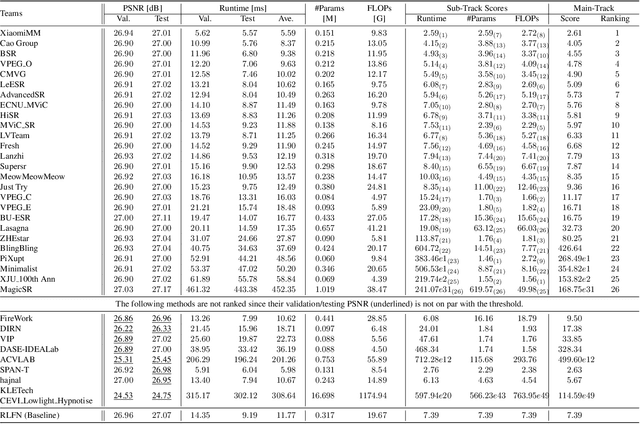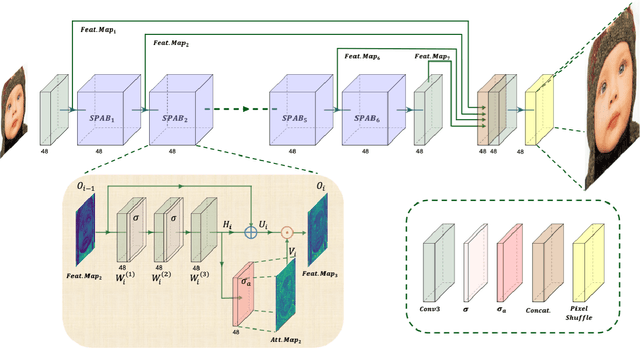Yunshuai Zhou
Dynamic Contrastive Knowledge Distillation for Efficient Image Restoration
Dec 12, 2024



Abstract:Knowledge distillation (KD) is a valuable yet challenging approach that enhances a compact student network by learning from a high-performance but cumbersome teacher model. However, previous KD methods for image restoration overlook the state of the student during the distillation, adopting a fixed solution space that limits the capability of KD. Additionally, relying solely on L1-type loss struggles to leverage the distribution information of images. In this work, we propose a novel dynamic contrastive knowledge distillation (DCKD) framework for image restoration. Specifically, we introduce dynamic contrastive regularization to perceive the student's learning state and dynamically adjust the distilled solution space using contrastive learning. Additionally, we also propose a distribution mapping module to extract and align the pixel-level category distribution of the teacher and student models. Note that the proposed DCKD is a structure-agnostic distillation framework, which can adapt to different backbones and can be combined with methods that optimize upper-bound constraints to further enhance model performance. Extensive experiments demonstrate that DCKD significantly outperforms the state-of-the-art KD methods across various image restoration tasks and backbones.
The Ninth NTIRE 2024 Efficient Super-Resolution Challenge Report
Apr 16, 2024



Abstract:This paper provides a comprehensive review of the NTIRE 2024 challenge, focusing on efficient single-image super-resolution (ESR) solutions and their outcomes. The task of this challenge is to super-resolve an input image with a magnification factor of x4 based on pairs of low and corresponding high-resolution images. The primary objective is to develop networks that optimize various aspects such as runtime, parameters, and FLOPs, while still maintaining a peak signal-to-noise ratio (PSNR) of approximately 26.90 dB on the DIV2K_LSDIR_valid dataset and 26.99 dB on the DIV2K_LSDIR_test dataset. In addition, this challenge has 4 tracks including the main track (overall performance), sub-track 1 (runtime), sub-track 2 (FLOPs), and sub-track 3 (parameters). In the main track, all three metrics (ie runtime, FLOPs, and parameter count) were considered. The ranking of the main track is calculated based on a weighted sum-up of the scores of all other sub-tracks. In sub-track 1, the practical runtime performance of the submissions was evaluated, and the corresponding score was used to determine the ranking. In sub-track 2, the number of FLOPs was considered. The score calculated based on the corresponding FLOPs was used to determine the ranking. In sub-track 3, the number of parameters was considered. The score calculated based on the corresponding parameters was used to determine the ranking. RLFN is set as the baseline for efficiency measurement. The challenge had 262 registered participants, and 34 teams made valid submissions. They gauge the state-of-the-art in efficient single-image super-resolution. To facilitate the reproducibility of the challenge and enable other researchers to build upon these findings, the code and the pre-trained model of validated solutions are made publicly available at https://github.com/Amazingren/NTIRE2024_ESR/.
LIPT: Latency-aware Image Processing Transformer
Apr 09, 2024Abstract:Transformer is leading a trend in the field of image processing. Despite the great success that existing lightweight image processing transformers have achieved, they are tailored to FLOPs or parameters reduction, rather than practical inference acceleration. In this paper, we present a latency-aware image processing transformer, termed LIPT. We devise the low-latency proportion LIPT block that substitutes memory-intensive operators with the combination of self-attention and convolutions to achieve practical speedup. Specifically, we propose a novel non-volatile sparse masking self-attention (NVSM-SA) that utilizes a pre-computing sparse mask to capture contextual information from a larger window with no extra computation overload. Besides, a high-frequency reparameterization module (HRM) is proposed to make LIPT block reparameterization friendly, which improves the model's detail reconstruction capability. Extensive experiments on multiple image processing tasks (e.g., image super-resolution (SR), JPEG artifact reduction, and image denoising) demonstrate the superiority of LIPT on both latency and PSNR. LIPT achieves real-time GPU inference with state-of-the-art performance on multiple image SR benchmarks.
 Add to Chrome
Add to Chrome Add to Firefox
Add to Firefox Add to Edge
Add to Edge